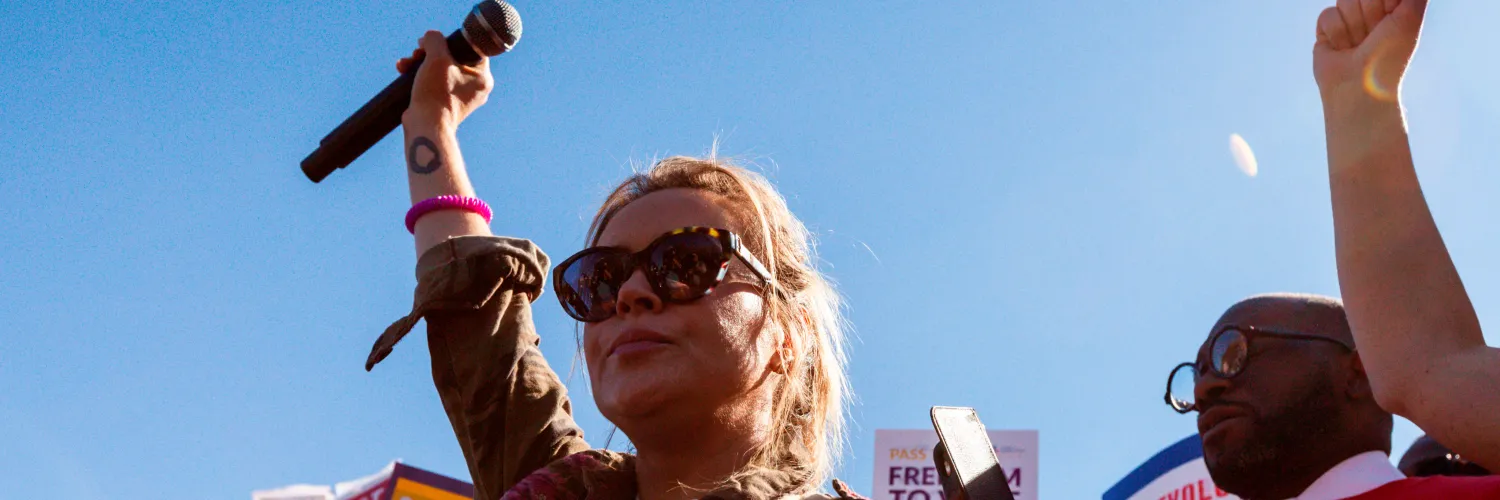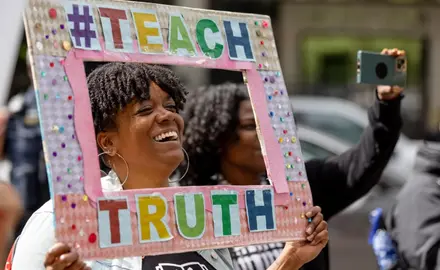We’re building the future we want
Attacks on the freedom to learn are on the rise. It’s in the news almost every day: book bans, Don’t Say Gay bills, and other efforts to whitewash our history and erase marginalized communities from the public square.
Groups like Moms for Liberty are using divisive rhetoric and electoral politics to drive a wedge between our communities and keep us from teaching the next generation our nation’s full history. But we know the power one person can have: In 2023, the Washington Post reported that the majority of over 1,000 book bans or challenges they analyzed were filed by just 11 people!
Imagine what we can do if we fight for the freedom to learn together. Our team at People For the American Way has put together the tools to help us do just that.
40+ years
For over 40 years, we’ve been tracking a dramatic rise in attacks on the freedom to learn, on our democracy, and on our communities.
We know community problems require community action. The Far Right’s aggressive campaigns, large followings and strong-arm tactics are designed to divide us. If we want to fight back, we have to be organized and decisive in our responses. That’s why we created this activist toolkit to help you challenge these tactics.
How to talk about censorship
Talking about censorship and book bans can be tricky! Here are some general points to keep in mind and help you guide the conversation.
We support the right of individual parents to decide what their kids are mature enough to read. Here’s what we oppose: some parents making a blanket decision not just for their kids, but for everybody else’s as well.
Book banning is a hallmark of authoritarian regimes. It’s both un-American and antidemocratic.
Students have a right to learn, and teachers to teach, the full history of our country.
That includes our troubled past and struggles with racial equity, gender equity, and LGBTQ Equity.
Whitewashing history benefits no one. It hurts students who are denied the opportunity to learn their true history and culture and it leaves all students less equipped for civic participation and succeeding on a national and world stage.
Groups that have taken up the banner of book-banning and censorship in the U.S. in recent years have overwhelmingly targeted books by and for people of color and LGBTQ people, a clear reflection of racism and bigotry.
Their tactics are extreme and even ridiculous. We have seen attempts to ban material about Ruby Bridges, the little girl who was the first Black student to integrate a New Orleans school. It’s even led to the banning of dictionaries! Where does it end?
Make no mistake: this is not just about attacking one or two books.
This is a growing political movement that is raising a lot of money and pushing an extensive MAGA agenda. It’s a launchpad for politicians and activists, including extremists who believe in dismantling our entire public education system.
This is the Scopes monkey trial all over again.
These are the same people who fought teaching science in our schools. These are the same people who screamed and spat on Black students trying to enter newly desegregated schools in the South. These are the same people who fought marriage equality. This is their latest desperate fight. Any time we start to make progress, what we see repeatedly throughout history is this attempt to take us back in time and control our children and our schools.
How to organize against censorship
“When the shouts of the censors are met by silence, when teachers, schools, and kids are left alone in defending materials against attack, attempts to ban books and programs often succeed. But when [community members] get involved, form alliances with the schools and organize broad community support, such challenges are more likely to be defeated.” - An Activist’s Guide to Protecting the Freedom to Learn, People For the American Way
For every person who tries to censor a book, there will be dozens of community members who won’t stand for it. Start by calling friends and colleagues, and build a nucleus of committed grandparents, parents, students, community members, and school teachers, librarians and administrators. Then reach out to other people in the community: civic leaders, faith leaders, business people, affinity groups.
You can recruit group members in lots of places, like at church, on NextDoor or Facebook, or in hobby-based groups!
Building connections can help make your team stronger. Set up a virtual or in-person meeting - in a coffee shop, on Zoom, or at your local library. Inform your group of the censorship threat that sparked your attention and the issues involved. Gather everyone’s contact information and decide how your group wants to communicate - via email or text works great!
Gather as much information as you can about the book challenge or threat, who’s behind it, and what impact it could have on your community. Set up tools like Google Alerts to keep on top of new information. Find out when your local school board meets and when you could make your voice heard. Follow your local elected officials and community leaders on social media and see what they’re saying about the freedom to learn.
If you’re fighting a specific ban/challenge: Meet with the person in charge of the challenged material. Learn how they use the material. Read it yourself. Develop a point-by-point rebuttal of the objector's claims.
The more times they get contacted, the better. Mobilize your allies to contact the school board and school district voice support for the challenged materials and/or express opposition to censorship. Send them emails, message them on social media, and tag them in your posts about the freedom to learn.
Write letters-to-the-editor and submit opinion pieces to local newspapers. These tactics will increase awareness of your cause, and may inspire others to take a stand. And to increase the reach of your piece, make sure you share it on social media and send it to your friends and family.
Contact reporters and tell them about the censorship challenge or authoritarian group. Identify someone who is comfortable talking to reporters. Send a press release announcing the formation of your group and its activities. Meet with newspaper editors or editorial boards to discuss the issue. Talk to local reporters about what’s going on. Don't be intimidated by the media- they're people whose job it is to find out and report what's happening in the community. You'll help them do their job by providing them with information!
Set up social media accounts for your local group. Use these pages to talk about what’s happening in your community. Talk about why having books that represent all of us in our classrooms matters, why learning our full history is so important, and about the kind of future you want to see for the next generation. You can also share news stories, go live to talk with your followers, and set up and invite folks to community events.
Mobilize your allies to attend all relevant school board meetings or public hearings. The more people you get there, the better. Get the agenda ahead of time. Ask for a chance to speak. Wear buttons and t-shirts, hold posters, so the board and media will see how strong your support is. Use our resources on how to speak out at school board meetings for guidance.
Get the signatures of as many people as possible on a petition opposing censorship. Present the petition at a school board meeting or other public forum. Send a copy to each school board member and copies to the local press.
Contact any groups or leaders who may have an interest in the matter or influence with the school board. Ask them to join your coalition. Prepare a coalition statement, have them co-sign it, and send it to the school board and media.
Meet with the community to discuss the issue. Publicize your meeting so you can attract a broad range of community members. Make sure you have a clear agenda, offer resources for community members to learn more and push back on the ban or authoritarian group, and don’t forget to bring a sign-up sheet so you can grow the number of members in your club!
Get a sense of how much the threat is driven by national MAGA groups that are posing as local activists. Is there a Moms for Liberty chapter or other authoritarian group in your town or city? Who organized the people who instituted the book ban or challenge you’re fighting?
Check out Right Wing Watch’s research for more information on major figures and groups threatening the freedom to learn.
In your meetings and letters, put the challenge in context by discussing broader issues such as censorship and academic freedom, any similar incidents that have taken place around the country, and the broader agenda of any national organizations involved in the challenge. When challenging school materials, many would-be censors claim to represent the views of "parents" and "Christians." Prevent them from staking a claim to these important constituencies by pointing out the inclusion of parents, churchgoers and clergy in your own group. Argue that neither parents nor Christians think as monolithic groups. Cast the would-be censors as a small but vocal minority in the community by pointing out the size of their group.
Find ways to continue the conversation about the freedom to learn. Protecting the freedom to learn often requires continued action - so keep your group together! Organize a banned book club, set up regular meetings, or start an email chain to keep your group in communication.
School censorship questions and answers
Censorship is the removal or restriction of materials by a governmental entity (e.g. a school system) with the intent of suppressing ideas and information. The hallmark of a censorship attempt is one person's desire to examine books, films and curricula for "objectionable" material as a means to control conduct or morals. Censors impose their views by deciding what others should not read or see. In schools, censorship occurs when materials are removed at least in part for ideological, religious or other personal reasons not having to do with their educational suitability.
Ask two questions.
- First, do the objectors demand removal of the material for all students, not just their own?
- Second, are the objections ideological, partisan, or otherwise non-educational in nature?
If you answer yes to both of these questions, it may be a censorship attempt.
One difference is crucial: concerned parents try to determine what books and materials their child can read. By contrast, those who attempt censorship insist that the school remove works from all children. And while concerned parents are content to speak for themselves, the would-be censor often claims to represent the views and concerns of all parents in the community, even in the face of strong evidence to the contrary.
First, try to resolve a complaint when it is first raised through reasoned and open discussion. Censorship attempts are more often stopped when a school system has in place formal reconsideration policies and procedures to make sure challenged material is judged on its educational merit. These policies should be clear, inclusive, and, most important, followed. Yet these approaches don't always work with more persistent challenges. Broader and more powerful organizing is often required. Organizing strategies vary, but the most powerful tool you can have is an alliance of community members and educators willing to act.
Censorship attempts threaten students' freedom to learn, teachers' academic freedom, and parents' rights. Most parents are outraged when they learn of attempts to ban the books and materials their children are reading. That's because efforts to remove books and materials for all school children undermine the rights of parents to ensure that their children receive the highest quality education. It also harms our kids, who deserve to see themselves and the history of their communities reflected in the materials they have access to in school. Someone who objects to a book has a right to stop their own child from reading it, but not their neighbor's.
More broadly, many censorship challenges represent conflicts between two opposing views of what public education in America should be. The most accepted view recognizes that creating responsible community members requires that young people be taught to think critically, to understand and respect the views of those different from them, and to respond to controversial ideas and different views with understanding and open talk, rather than with censorship and suppression.
The opposing minority view rejects teaching children critical thinking skills, self-reliance, and an appreciation for diversity. Under the guise of “parents’ rights,” this extremist and reactionary minority believes they can force schools to whitewash history and force their narrow world view, steeped in white supremacist ideology, on the next generation.
Taking back our school boards
Determine the types of election-related activities you want to undertake and organize in a way that helps you carry out those tasks. Some of your supporters may choose to work in a strictly nonpartisan fashion to educate voters, while others may decide to work directly for the election of a specific candidate. There's plenty of room for more than one pro-education effort.
Determine the filing deadline for candidates, the date of the election, campaign finance requirements and deadlines, and what else might be on the ballot. Resources for answering these questions include the county or municipal board of elections and the school district.
Every campaign has finite resources – money, volunteers, and so on – and must choose how best to spend them. If you plan to work in an area larger than a single school district (such as county-wide), carefully weigh the question of which districts merit your attention.
- What districts have competitive races?
- Which and how many districts are most threatened by the opposition?
- Where are your strongest organizational resources?
- Where are you most likely to achieve maximum impact?
- Where are the opponents most vulnerable?
- In how many districts can you and/or your group effectively work simultaneously?
- Which districts' voters are likely to be most sympathetic to your cause?
Put together the candidates’ past records and current positions as a tool for evaluating their candidacies. For incumbents, the record should be fairly easy to construct. If you have been monitoring school board meetings, you should have a fairly complete record of their statements and votes. If you haven't, contact the school superintendent's office or search online to get access to the official school board minutes and other meeting records.
Search for press coverage of school board meetings of members. Don't overlook local publications; you may find useful stories about otherwise unnoticed controversies.
Ask local parent-teacher associations and teachers’ unions if they have information to share.
Pay particular attention to candidates' affiliations with local or national organizations. People For the American Way can help you find information about national MAGA political organizations – what they stand for, how they organize, what their tactics are, and more.
Getting out the vote
Create a list of people in your network - friends, family, and people like you - who you think would be willing to vote to protect the freedom to learn. Reach out to other people and groups organizing in your community. Get a list of registered voters in the area from your local voter registrar; if you have sufficient time and resources, you can use the list to identify registered supporters. Make sure your friends and family are registered to vote too!
Reach out for the first time well before the election. Find out if the person is registered to vote and explain why this election is important. If you send information by mail, you'll be able to get into greater detail; but a phone call or text message allows you to personally evaluate which voters are your strongest supporters and should be placed on your priority list. Either way, invite interested voters to become more involved by joining your effort. If you encounter people who clearly do not agree with you on the issues, drop them from your list. A GOTV operation has one goal: find supportive voters and make sure they vote.
If you have the resources, you should call all potential voters, beginning with your most likely supporters, on the day before the election or on election day.
Callers should:
- Remind voters to get to the polls and vote
- Ask them to make sure that their friends and family vote
- Tell them when the polls are open
- Ask them if they need help getting to the polls
- Above all, tell them that their vote is crucial!
It’s time to get voters to the polls. On election day you should ideally have enough phones and callers to contact all the names on your lists and a carpool system capable of driving everyone who needs a ride to the polls.
Help drive support on social media by posting your “I Voted” selfies!
The Latest
Fight censorship with us



